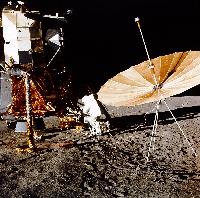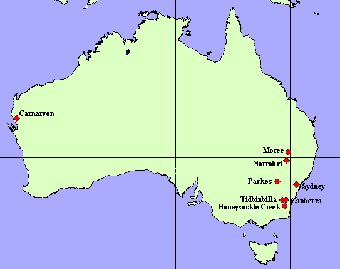
Photo Hamish Lindsay: The Honeysuckle Creek antenna.
 Photo Hamish Lindsay: The Honeysuckle Creek antenna. |
 Photo NASA: The Goldstone dish. |
The flight plan had the astronauts performing the Extra Vehicular Activity (EVA), or moonwalk, shortly after landing. The Moon was not due to rise at Parkes until 1:02 p.m. (AEST), by which time the EVA would have been completed. In addition, the astronauts were to deploy a 3 metre, erectable, S-band antenna, as was later done on Apollo 12 and 14. The purpose of this was to provide greater signal strength from the Moon.
All this was changed some two months before the mission. In May 1969 it was decided to alter the Apollo 11 mission plan and allow a rest period before commencing the lunar EVA. This would have given the astronauts an opportunity to adjust to the Moon's 1/6th gravity, and to start the EVA refreshed. The new plan had the EVA starting about ten hours after landing, at 4:21 p.m. (AEST), which was some twenty minutes after the Moon had set for the Goldstone dish, but which had the Moon high overhead at Parkes. Parkes' role was consequently upgraded from backup to PRIME receiving station.
The subsequent upgrading from backup to prime station meant that all equipment had to be duplicated at Parkes. Two sets of receivers, two sets of microwave relays, two sets of voice and command links etc. were installed.
Since Parkes could only receive and not transmit, it was regarded as an auxiliary station to Honeysuckle Creek and was assigned the honorary designation of station number 23 in the Manned Space Flight Network (MSFN).
 Photo NASA: The Apollo 12 erectable S-band antenna. Pete Conrad is at the MESA. |
Once the decision had been made to include television, the addition of Parkes was even more desirable. The large collecting area of the Parkes telescope provided for extra gain in signal strength from the Moon. This meant that the astronauts would not have to deploy their 3 metre, erectable, S-band antenna. The tight schedule of the first moonwalk was such that NASA planners had decided the extra time and effort needed in deploying the antenna (about 20 - 45 minutes) was not warranted. Instead, the smaller 0.66 metre S-band antenna, located at the top of the LM ascent stage, was used, and having Parkes in the link would provide the extra gain in signal strength. NASA wanted TV pictures of Armstrong descending to the lunar surface, which of course would have been before he could deploy the erectable S-band antenna. Parkes thus provided the maximum reliability and quality for the telemetry, which the mission planners demanded.
The roles of the other Australian stations:
Honeysuckle Creek was the main NASA tracking station in Australia for all the manned Apollo missions and co-ordinated the tracking effort between the various NASA stations and Parkes. The stations were operated for NASA by the Department of Supply and manned by Australians.
In the pre-mission planning, Tidbinbilla was scheduled to track the LM, Eagle, on the lunar surface, and Honeysuckle Creek was to track the command module, Columbia, in lunar orbit. Tidbinbilla had a maser low noise amplifier that gave it greater sensitivity than Honeysuckle Creek.
A third NASA tracking station at Carnarvon in Western Australia was scheduled to track the LM with its 9 metre antenna and receive the telemetry from the surface experiments the astronauts were to deploy. The signals were then to be sent to Houston via the INTELSAT III Pacific geostationary satellite.
The CSIRO Radiophysics Division's Culgoora radioheliograph, near the town of Narrabri in northern NSW, was used to observe the Sun and warn NASA of impending solar flares. Because the astronauts would be outside the protection of the Earth's radiation belts, a sudden eruption of a solar flare could expose the astronauts to lethal doses of radiation. The radioheliograph would give them sufficient warning to abandon the EVA and return to the relative safety of the LM.
A fire leads to a change of plan:
The personnel at Tidbinbilla, under the directorship of Don Grey, were looking forward to receiving the historic television of the EVA. Unfortunately for Tidbinbilla, a fire in the transmitter just one day into the mission on 18 July altered the plan drastically. Despite engineers being able to repair the damage in just 12 hours, the incident dented NASA's confidence in the station, so its role was switched with Honeysuckle Creek. This was a great disappointment to the engineers at Tidbinbilla who had worked tirelessly to get the system back up and running in such a short time. For Honeysuckle Creek however, this twist of fate would prove to be significant.
 |